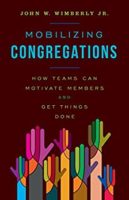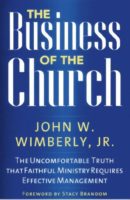As a consultant, when I first meet with the leadership of a congregation, I ask them a straightforward question: “What is your congregation’s primary purpose, your driving reason for being?” Usually, the response is halting, filled with qualified statements, and includes a laundry list of things the congregation does. The exchange leaves me and the leaders with one clear conclusion: they aren’t sure what their primary purpose is. They have purposes. But not one, clear, driving purpose.
I can receive this response even in congregations that have recently gone through a strategic planning process. They emerge from the planning exercise with goals and strategies. But a clear, passionate sense of purpose? Too often, it is missing.
As a consultant, my biggest surprise continues to be the lack of clarity of purpose that I find among many congregations. Even some growing congregations are doing a little of this and a little of that successfully but without a clear, big picture intentionality to guide their decision-making. Despite having no well-defined sense of purpose, congregations still manage to do wondrous things for their members and community. But their impact could be taken to an exponentially higher level if they would focus their energy and resources with a laser-like intensity.
Patrick Lencioni, a great synthesizer of organizational insights, offers the following keys to achieving clarity of purpose in an organization:
- Create Clarity of Purpose
- Create a Cohesive Leadership Team (Staff and Lay)
- Over Communicate Clarity
- Reinforce Clarity
We live in a world that is rapidly changing. I am not convinced it is changing all that much faster than numerous other times in history. Think about being a congregation or pastor during the Industrial Revolution, on the western frontier of the United States (like my great grandfather) or the Great Depression (like my grandfather and father). Change is part of life. Pastors and congregations who don’t like change probably won’t like ministry. Pastors and congregations who embrace and even relish change find ministry to be among the most fascinating occupations possible.
Given the changes around and within us, we need a clear plan for moving into the future. I am convinced that Moses, Paul, the Reform movement in Judaism and the other great builders of religious communities had strategic plans. Obviously, they didn’t call them strategic plans. However, they had the core elements of a strategic plan: a vision of where they were headed, broad goals to get there, and specific strategies to realize the goals.
At the heart of any effective strategic planning process is an energizing clarity of purpose about a congregation’s life for a three year period. If the purpose has engaged the imaginations and hearts of congregants, a member should be able to say, “This is what we are about. This is our purpose for the next few years.” The defined purpose will then shape the congregation’s decisions about its programs, staffing and finances going forward.
Clarity of purpose embodied in a strategic plan creates an internal discipline that is sorely lacking in many congregations. So, for example, if a member approaches the governing board with an idea for a program, the board no longer starts a debate about the value of the program. Instead, the board begins by asking itself, “Does this program contribute to our primary purpose? Or, is it a tangent that will divert energy and money away from our primary purpose?”
As a pastor, I found this aspect of clarity of purpose to be the most helpful. It is very difficult to say “no” to a congregational member or committee when they have developed enthusiasm for a particular idea or project. Indeed, we hope people will come to us filled with passion for some new ministry. But what if the new ministry will pull the congregation away from what it does best and its defined primary purpose?
The thought of a new organ pops into my mind. I love organ music. I also know what happens to the life of a congregation when they decide to build a new organ. Unless the congregation is huge, a new organ typically will require a large fundraising effort. It will need an organ committee/team and some of the staff to work with architects and organ builders. Money contributed to the organ cannot be used to fund the explicit primary purpose. In other words, for a period of time, the new organ becomes the primary purpose of the congregation.
All of this is fine if the primary purpose of the congregation is to create inspiring music. But if it isn’t, if music is one part of a larger purpose and an organ fundraising campaign and construction period dominate the life of a congregation for a couple of years, what happens to the primary purpose of the congregation (whatever it is) during that period? Too often, it gets put on a side track until the organ is completed.
When a congregation and its leadership are very clear about their primary purpose, they will not allow themselves to get pulled into projects that don’t further the primary agenda. To members and committees with great but side-tracking ideas, their response will be, “Thank you for your enthusiasm and creativity. This is a great idea. But it is not a great idea for us right now because here is the purpose we have all agreed to pursue. This project doesn’t currently mesh with our primary purpose.”
Will such a response satisfy all those whose ideas are rejected in the name of clarity of purpose? No. But it will satisfy reasonable people. And frankly, those are the only people we can satisfy.
John Kotter, the Harvard academic who writes on organizational issues, insists (correctly, in my opinion) that an organization’s clarity of purpose should be explainable in a matter of a few minutes. He isn’t arguing for sound bites. He simply realizes that if we can’t summarize the purpose of our congregation in a few minutes, then we probably aren’t clear about the purpose. Clarity of purpose leads to clarity of language.
What is the clear purpose of your congregation? Is everybody in the leadership committed to the purpose? Are leaders willing to exercise decision-making discipline to stay focused on the purpose? Is the purpose communicated to the congregation (and community) repeatedly? Are the people, financial and facilities resources of the congregation aligned with the purpose? These are questions to consider if we desire a purpose-driven congregation.
John Wimberly is an experienced pastor and consultant. As a consultant, he has worked with congregations and judicatories on strategic planning, staff designs for the 21st century, and congregational growth as well as financial and administrative management. He has MBA, MDiv, and PhD (theology) degrees. His books focus on effective management and leadership. John believes congregations can have a bright future!



